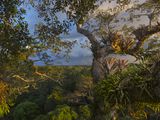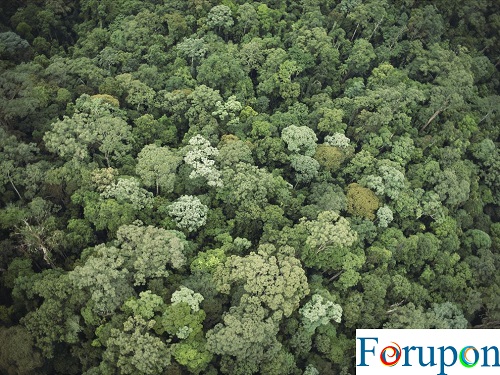Rainforest
A rainforest is an area of tall trees and a high amount of rainfall. Tropical Rain Forest For upon |A rainforest is simply an area of tall, mostly evergreen trees and a high amount of rainfall. This dense rainforest is on the island of Borneo, which straddles two oceans (the Indian and the South Pacific) and is shared by three nations (Indonesia, Malaysia, and Brunei).
Rain Forest Mist
Many rainforests experience more than 100 inches of rain every year. Precipitation may also come in the form of fog and mist, like the clouds surrounding this rainforest in Borneo. Tropical Rain Forest.
World of Rain Forests
Different types of rainforests thrive on every continent except Antarctica.
Rain Forest Layers
There are four major layers in a rainforest: emergent, canopy, understory, and forest floor. Each layer has unique characteristics based on differing levels of water, sunlight, and air circulation. While each layer is distinct, they exist in an interdependent system: processes and species in one layer influence those in another. Tropical Rain Forest.
Emergent Layer
The uppermost layer of a rainforest is the emergent layer. This is the emergent layer of the rainforest surrounding the ancient Maya city of Rio Azul, Guatemala.
Towering Trees
Trees in the emergent layer can grow as tall as 200 feet. Foliage is often sparse on tree trunks but spreads wide as the trees reach the sunny upper layer. Here, moss covers the towering trees of the Great Bear Rainforest in British Columbia, Canada.
Kapok Tree
Kapok trees like this one in Yasuni National Park, Ecuador, dominate the emergent layer of the Amazon River rain forest. Unlike many rainforest species, the kapok is deciduous—it sheds all its leaves during the dry season.
Leeches Long-tongued Bat
Animals often maneuver through the emergent layer’s unstable topmost branches by flying or gliding. Bats, like this Leache’s long-tongued bat in Cuba, are a common part of all layers of a rain forest.
Harpy Eagle
Large raptors, such as this harpy eagle, are the emergent layer’s top predators.
Canopy
Beneath the emergent layer is the canopy, a deep layer of vegetation whose dense network of leaves and branches forms a roof over the two remaining layers. This canopy is shading the giant rainforest surrounding the Congo River in the Democratic Republic of Congo.
Strangler Fig
Many trees in the rainforest encase their seeds in fruits. Figs, such as this strangler fig on Fraser Island, Australia, maybe the most familiar fruit tree in the rain forest.
Sifaka
As in the emergent layer, animals in the canopy are often adept at swinging and leaping through the dense network of branches. Animals, such as this sifaka in Madagascar, help disperse seeds in the canopy. Figs or other sweet fruit entices animals, which eat the fruit and deposit seeds on the forest floor as droppings.
Insects
Thousands and thousands of insect species can also be found in the canopy, from ants to beetles, bees to butterflies. Many of these insects are the principal diet of the canopy’s reptiles, amphibians, and birds.
Philodendron
Plants in the understory such as this philodendron, are much shorter and have larger leaves than plants that dominate the canopy. Understory plants’ large leaves catch the minimal sunlight reaching beyond the dense canopy.
Heliconia
Understory plants often produce flowers that are large and easy to see, such as this Heliconia species in Dominica, or have a strong scent, such as orchids. These features attract pollinators even in the understory’s low-light conditions.
Cassowaries
The fruit and seeds of many understory shrubs in temperate rainforests are edible. Here, a cassowary looks on while one of his chicks picks a berry in the Wet Tropics World Heritage Area, in Queensland, Australia. Tropical Rain Forest.
Jackson’s Chameleon
Animals call the understory home for a variety of reasons. Many take advantage of the dimly lit environment for camouflage. This chameleon, native to East Africa and an invasive species in Hawaiian rain forests, can even change colors to camouflage itself.’
Tiger
Rainforest understories are home to some of the most endangered and familiar rainforest animals—such as forest elephants, pythons, gorillas, and tigers like this one in the Bandhavgarh Tiger Reserve, India.
Leafcutter Ants
The forest floor is the darkest of all rainforest layers, making it extremely difficult for plants to grow. Leaves that fall to the forest floor decay quickly—or are carried away by leafcutter ants like these workers in Brazil.
Erosion
The soil of rainforest floors is typically nutrient-poor; the rich biodiversity of the ecosystem is found in the top three layers. The erosion of this former rainforest floor in Brazil is a familiar sight in deforested areas.
Mushroom on Stump
Decomposers, such as this mighty mushroom in Gifford Pinchot National Forest in the U.S. state of Washington, thrive on the forest floor. The organic matter falls from trees and plants, and these organisms break down the decaying material into nutrients. Slugs, termites, and snails often consume fungi as well as decomposing organic matter.
Rhinoceros Viper
Dozens of predators, like this well-camouflaged, well-fed rhinoceros viper in Cameroon, consume the decomposers.
Komodo Dragon
Large animals such as wild pigs, armadillos, and anteaters forage in the decomposing brush for tasty insects, roots, and tubers. This Komodo dragon, sunbathing on the edge of a rain forest in Komodo National Park, Rinca Island, Indonesia, eats mostly carrion—carcasses of decomposing deer and pigs.
Canoe in the Congo
Waterways often border or thread through rainforests. The rainforest surrounding the Congo, snaking through the Republic of the Congo above, is the second-largest in the world.
Oceanic Rain Forest
Oceans, too, can border rainforests. British Columbia’s Great Bear Rainforest borders Canada’s Pacific coast.
West African Dwarf Crocodile
Many rainforest species navigate between the forest floor and aquatic habitats. This West African dwarf crocodile, in the Petit-Loango Reserve, Gabon, is a vulnerable species.
Fabulous Frogs
Colorful and sprightly frogs are some of the most recognizable residents of the rainforest floor.
Roosevelt Elk
Temperate rain forests are located in the mid-latitudes, where temperatures are much milder than in the tropics. Temperate rainforests are found mostly in coastal, mountainous areas, such as Prairie Creek Redwoods State Park, California. Tropical Rain Forest.
Kermode Bear
The animals of the world’s temperate rainforests are wildly diverse, from tiny insects to large mammals, including this Kermode bear in a crabapple tree of the Great Bear Rainforest of British Columbia, Canada.
Juan Fernandez Firecrown
One of the most dazzling birds of the temperate rainforest is the Juan Fernandez forecrown, a hummingbird species found only on Robinson Crusoe Island, Chile.
Tsimane Women
Rain forests have been home to thriving, complex communities for thousands of years. The Tsimane culture, for example, is indigenous to the lowland rain forests of Bolivia.
Mbendjele Spirit
The Mbendjele and other so-called “pygmy” communities are indigenous to the Congo rain forest in Central Africa. Here, a Mbendjele community celebrates with an embodiment of the forest spirit Ekambo Deki.
Chimbu Girl
Although many communities indigenous to the world’s rain forests maintain their traditional culture, they also welcome modern and Western influences. Here, a Chimbu girl shows off both traditional fashion and pink bubble gum. Tropical Rain Forest.
Tlingit Girl
The Tlingit culture is indigenous to the rain forests of the Pacific coasts of the U.S. and Canada. Rainforest climate, seasonal variations, and biodiversity remain a vital part of the Tlingit community today.
Yanomamo Youth
One of the most-studied cultures of the dozens of communities indigenous to the Amazon rainforest is the Yanomamo. The Yanomamo live in villages throughout northern Brazil and southeastern Venezuela.
Chopsticks
Rain forests provide us with many products that we use every day. Tropical woods such as teak, balsa, rosewood, and mahogany are used in flooring, doors, windows, boatbuilding, and cabinetry. These chopsticks are products of timber culled from rainforests in Papua New Guinea.
Bamboo
Fibers such as raffia, kapok, rattan, and, pictured here, bamboo, are used to make furniture, baskets, insulation, and cord.
Curing Vanilla
Cinnamon, vanilla, nutmeg, and ginger are just a few spices of the rainforest. Here, workers in Klaten, Java, Indonesia, put out semi-cured vanilla beans to dry in the sunlight.
Logged Forest
Rain forests are disappearing at an alarmingly fast pace, largely due to human development over the past few centuries. Logging, for instance, contributes to erosion as well as habitat destruction and carbon emissions. Logging is a familiar and lucrative business in the Pacific Northwest, including the Gifford Pinchot National Forest in the U.S. state of Washington, above.
Gold Mine
Rainforests are also threatened by mining operations, such as this booming gold mine cut out of the rainforest in Serra Pelada, Brazil. Rainforest ecosystems are destroyed by infrastructure such as roads, as well as the mines themselves. Tropical Rain Forest.
Oil Palm Plantations
Agriculture, including both farming and ranching operations, is another contributor to deforestation around the world. Here, trees in oil palm plantations encroach on rainforest habitat in the Jengka Triangle Region, Malaysia.
Zip Line
Conservationists, governments, and businesses are working together to sustainably manage rainforests around the world. Ecotourism is one-way local communities and business owners support wild ecosystems as well as their economic well-being. This lodge and eco-tourism destination on Costa Rica’s southern Pacific coast offers free, customized tours to local elementary school students as well as zip-line tours of the rainforest canopy. Tropical Rain Forest.
Rio Canande Reserve
Nonprofit organizations are tackling rainforest conservation through a variety of different approaches. The Rainforest Trust, for example, supports local conservation groups around the world in purchasing and managing critically important habitats. In Ecuador, the Rainforest Trust worked with the Fundación Jocotoco to acquire 1,222 more acres for the Río Canandé Reserve, above, which is considered to have one of the highest concentrations of endemic and threatened species in the world.
Hoh Rainforest
The Olympic National Park in Washington is one of the most diverse and unique rainforest ecosystems in North America. Hoh rainforest is located in Washington, United States.
Rainforest Structure
Types of Rainforests
Temperate Rainforests
People and the Rainforest
Tlingit
Benefits of Rainforests
Threats to Rainforests
Rainforest Conservation

Kapok trees are keystone species in many rainforest ecosystems.
Photograph by Steve Winter, National Geographic
Jungles and Rain Forests
- National Geographic News: How Indigenous Tribes Protect the Rain Forest
- National Geographic Environment: Rain Forest
Images
Video
Websites
- Smithsonian Tropical Research Institute
- Mongabay: Rainforests
- National Geographic Education: Rain Forests
The article was originally published here.


Comments are closed.